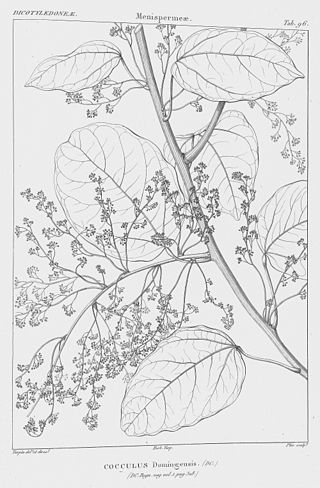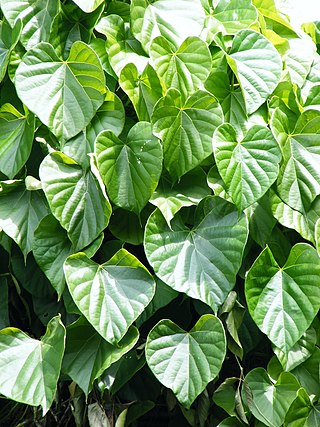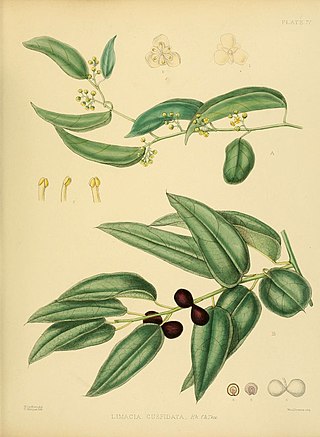
The Celastraceae are a family of 98 genera and 1,350 species of herbs, vines, shrubs and small trees, belonging to the order Celastrales. The great majority of the genera are tropical, with only Celastrus, Euonymus and Maytenus widespread in temperate climates, and Parnassia (bog-stars) found in alpine and arctic climates.

Menispermaceae is a family of flowering plants. The alkaloid tubocurarine, a neuromuscular blocker and the active ingredient in the 'tube curare' form of the dart poison curare, is derived from the South American liana Chondrodendron tomentosum. Several other South American genera belonging to the family have been used to prepare the 'pot' and 'calabash' forms of curare. The family contains 78 genera with some 440 species, which are distributed throughout low-lying tropical areas with some species present in temperate and arid regions.

Cocculus is a genus of four species of woody vines and shrubs, native to tropical and subtropical regions of Africa and Asia.

Anomospermum is a genus of flowering plants in the family Menispermaceae. It consists of five species from tropical America, ranging from Nicaragua to southern Brazil.

Abuta is a genus in the flowering plant family Menispermaceae, of about 32 species, native to tropical Central and South America.

Odontocarya is a plant genus in the family Menispermaceae. It includes 38 species native to the tropical Americas, ranging from southern Mexico to northern Argentina.

Hyperbaena is a genus of plants in family Menispermaceae. It includes 23 species native to the tropical Americas, ranging from Cuba and southern Mexico to northeastern Argentina.

Tinospora is a genus of succulent woody climbing shrubs. Thirty-four species are currently recognized. Species generally send down long aerial roots from host trees. They have corky or papery bark. They are found in tropical and sub-tropical parts of Asia, Africa and Australia. The most common species are T. cordifolia and T. crispa.
Albertisia is a genus of flowering plants belonging to the family Menispermaceae.
Syrrheonema is a genus of flowering plants belonging to the family Menispermaceae.
Diploclisia is a genus of flowering plants belonging to the family Menispermaceae.

Hypserpa is a genus of flowering plants belonging to the family Menispermaceae.
Parabaena is a genus of flowering plants belonging to the family Menispermaceae.
Pycnarrhena is a genus of flowering plants belonging to the family Menispermaceae.
Leptoglossis is a genus of flowering plants belonging to the family Solanaceae.
Penianthus is a genus of flowering plants belonging to the family Menispermaceae.
Sciadotenia is a genus of flowering plants belonging to the family Menispermaceae.
Rhaptonema is a genus of flowering plants belonging to the family Menispermaceae.
Elissarrhena is a genus of flowering plants belonging to the family Menispermaceae.
Hyalosepalum is a genus of flowering plants belonging to the family Menispermaceae.









